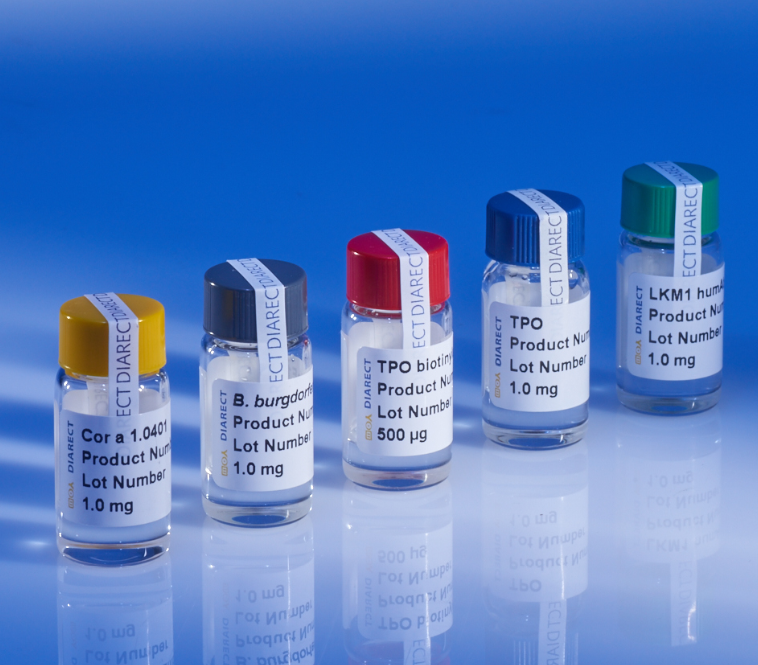Proteinase 3 (PR3)/蛋白酶3
Proteinase 3 (PR3)
Diseases:
Wegeners Granulomatosis
Proteinase 3 (PR3) is a neutral serine protease stored in the azurophilic neutrophilic granulocytes, consisting of 228 amino acids (MW 29-33 kDa depending on glycoform). It has substantial sequence homology with neutrophil elastase, cathepsin G and azurocidin. The primary function of these neutrophil-derived serine proteases is thought to be degradation of extracellular proteins at sites of inflammation, but excessive or prolonged proteolytic activity may cause harmful effects in the body.
Anti-neutrophil cytoplasmic antibodies (ANCA) are autoantibodies directed against constituents of neutrophil cytoplasm. Two main types of ANCA are present in patients with ANCA-associated systemic vasculitis: cANCA (cytoplasmic pattern in indirect immunofluorescence test, IIF), which target PR3, and pANCA (perinuclear), which are directed against MPO.
cANCA/PR3-ANCA exhibit high specificity as well as sensitivity for Wegeners Granulomatosis, a necrotizing vascultis syndrome, and are much less frequently found in Churg-Strauss Syndrome and Microscopic Polyangiitis. In active Wegener the prevalence of this antibody is almost 90%, decreasing to 30-40% during remission. There is consensus in the literature that diagnostic specificity is optimally improved by combining IIF on neutrophils together with standardized PR3 ELISA. Presently PR3-ANCA is detected by both traditional direct and capture ELISAs; very recently a so-called anchor ELISA (using a bridging molecule to prevent direct adhesion on the plastic surface and therefore preserving all epitopes for binding with ANCA) as well as multiplex systems (e.g. measuring PR3, MPO and GBM autoantibodies in one tube) have also been described.
The close relationship between ANCA and ANCA associated vasculitis, in particular with disease activity, has suggested that ANCA may be pathogenic. Interestingly the parenchymal pneumocytes and macrophages, and not the neutrophils, express PR3 most strongly and may, for instance, contribute to lung damage in patients with WG via direct interaction with ANCA. In this view vascular damage is caused by ANCA-activated leukocytes; whether endothelial damage can arise by direct pathological action of ANCA on endothel cell surface has been speculated for years, but is not rigorously proven.
Human native proteinase 3 (PR3) by DIARECT is purified from polymorphonuclear leukocytes of peripheral human blood.
相关疾病:(中性粒细胞特异性自身抗体相关疾病)
韦格纳肉芽肿病的抗中性粒细胞胞浆抗体(ANCA)是在坏死性小血管炎中发现的。这些抗体大部分属于IgG类型,在乙醇固定的中性粒细胞和单核细胞的间接免疫荧光反应中有很明显的阳性反应,它们的主要靶点是蛋白酶3(PR3)(即是所谓的胞浆型cANCA)和髓过氧化物酶(MPO)。抗髓过氧化物酶抗体在大多数的血清中发现,即产生了核周型pANCA。大部分的血清通过间接免疫荧光反应表现出pANCA模型但并不包含MPO抗体。抗PR3特异性抗体是中性粒细胞特异性自身抗体相关脉管炎疾病,特别是韦格纳豆芽肿病的一种敏感的和特异性的标记物。在临床上,如果检出抗MPO抗体,那么很可能是坏死性脉管炎或原发性的微量免疫坏死性和新月体肾小球肾炎。如今,抗中性粒细胞细胞质抗体在系统性炎症疾病的临床诊断中一直在增加。对于它们的描述大概要回到27年前,它们在常规的脉管炎检测中变成了一种重要的标准。现在建立的ANCA确定的方法是人中性粒细胞的间接性免疫荧光反应和抗原特异的ELISA,线性分析或者多通道分析。 蛋白酶3是在嗜天青中性粒细胞中的一种中性丝氨酸蛋白酶,由228个氨基酸组成,分子量为29-33kDa(不同糖基化类型有所不同)。它实际上与中性白细胞弹性蛋白酶,组织蛋白酶G,天青素有序列同源性。这些中性粒细胞它主要的功能就是降解炎症部位的细胞外蛋白。但是过量或拖延的蛋白水解活性可能会对机体有害。抗中性粒白细胞胞质抗体(ANCA)是直接抗中性粒白细胞胞质组分中。在ANCA相关的系统性血管炎患者中发现了两种主要的ANCA :cANCA(间接免疫荧光检测IIF的胞质类型),靶向PR3抗原;pANCA(核周),靶向MPO抗原。cANCA/PR3-ANCA对韦格纳肉芽肿病和坏死性脉管炎有很高的特异性和敏感性,但是在显微镜下型多血管炎和丘施二氏综合征患者中不常见。该抗体在活动性韦格纳肉芽肿病患者中的检出率几乎为90%,当症状缓解后降至30-40%。目前已有共识。该病的诊断需要将中性粒白细胞间接免疫荧光检测(IIF)和标准化的PR3 ELISA检测相结合。之前,检测PR3-ANCA可以通过传统直接法ELISA也可以通过捕获法ELISA。目前,还可用锚定法ELISA(通过搭桥分子阻止蛋白与固相表面的直接结合,从而是所有的表位都结合到ANCA)和多通道检测系统(如在一个管子中同时检测PR3,MPO和GBM自身抗体)检测。 ANCA和ANCA相关血管炎,尤其是疾病活动性之间的密切联系,表明ANCA可能是致病的。有趣的是实质肺细胞和巨噬细胞,而不是中性粒细胞,强烈表达PR3,并可能比方说通过与ANCA的直接相互作用促成WG病人的肺损伤。从这种观点来看,血管损伤是由ANCA激活的白细胞引起的,内皮损伤是否会通过ANCA在内皮细胞表面的直接病理活动而加重,这个问题已经争论了很多年,至今仍没有一个准确的定论。 DIARECT生产的人天然蛋白酶3(PR3)是从人外周血中的多形核白细胞中纯化的。




